The Problem:
Many of the permanent magnets currently being made are made of rare-earth metals. These metals have operational temperatures below 150°C. This is problematic for motor applications (i.e., electric motors) that require operational temperatures of at least 160°C, and leads to a loss in the magnetic properties of the metals. Further, sources for the rare-earth metals are limited to a few countries, and metal price is unpredictable/controlled by those countries, creating an unstable rare-earth metal market and expensive rare earth materials.
The Solution:
Researchers at the University of Alabama have developed magnetic exchange coupled core-shell nanomagnets to replace the use of rare-earth metal magnets. The technology consists of a method to produce barium hexaferrite nanoparticles for the creation of magnets that don't use rare-earth metals, allowing lower expense magnets that have operational temperatures over 250°C.
 Experimental/Theoretical Magnetic Energies
Experimental/Theoretical Magnetic Energies
 Magnet Structure
Magnet Structure
Benefits:
• No rare-earth metals used: less expensive materials, easier obtainability.
• Higher Curie temperature than rare-earth permanent magnets.
• Invented core-shell nanomagnets can be used at 250°C.
The University of Alabama Research Office of Innovation and Commercialization (OIC) is a non-profit corporation that is responsible for commercializing University of Alabama technologies and for supporting University research. At OIC, we seek parties that are interested in learning more about our technologies and commercialization opportunities, and we welcome any inquiries you may have.